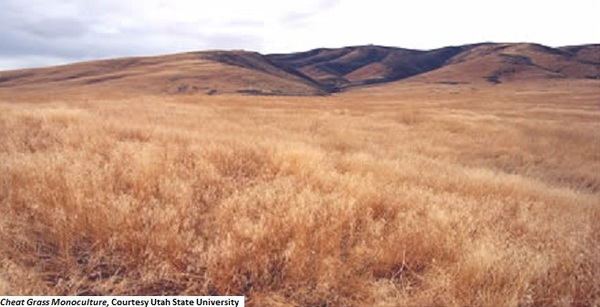Dublin Core
Title
Description
Plants and animals that made their way to Utah unleashed unintended consequences upon arrival.
People aren’t the only ones who make journeys. When people traveled from place to place, they introduced new plants and animals into the areas they settled. These “non-native” species are records of human contact, migration, and colonization. Non-native species often traveled as invited guests — a little something to make new surroundings appear more familiar — or as unexpected stowaways, secreted in clothing, bedding, and animal fur.
In April 1877, for example, two hundred English sparrows fluttered from their crates in the Salt Lake Valley. The Walker Brothers, well-known Salt Lake merchants, imported the birds to help eat insects then plaguing Utah’s fruit trees. The birds reminded British immigrants of home and were initially welcome. Ten years later, though, most people saw the sparrows as obnoxious pests that decimated Utah’s cereal crops.
On the other hand, cheatgrass came to Utah as a stowaway. The grass originated in southwest Asia and came to the United States in the early 1890s. It traveled west with the railroad, hiding inside straw bedding, packing, and commercial grain seed. Sounds harmless enough, but cheatgrass is highly flammable and lengthens the fire season by up to three months. After a fire, the grass grows and spreads quickly, and severely limits an area’s biodiversity. Some biologists refer to cheatgrass as a “biotic virus.”
In the case of the English sparrows, Utahns learned to live with them. When farmers discovered in 1914 that the sparrow feasted on the invasive alfalfa weevil, the bird was suddenly popular again.
Cheatgrass is another matter. To control it, biologists may introduce yet another newcomer to the Great Basin ecosystem: a Eurasian fungus that prevents cheatgrass from germinating. It sounds like a good idea. Unlike the Walker Brothers and the English sparrow, researchers today carefully monitor introduced species. But the challenge will be to make sure the new fungus does not cause more problems than it solves.
Creator
Rebecca Andersen for Utah Humanities © 2014
Source
Image: Cheat Grass Monoculture. Invasive weeds have innovative and aggressive survival strategies, but lack natural predators. These weeds injure, overwhelm and out-compete native plants in various ways. This results in the loss of local plant diversity. Courtesy of Utah State University's Invasive Weeds Blog.
_______________
See Alfred W. Crosby Ecological Imperialism: The Biological Expansion of Europe, 900-1900 (New York City: Cambridge University Press, 1986, 1993, 2004); “Black Fingers of Death—the Bane of Cheatgrass,” United States Department of Agriculture, Forest Service, (accessed August 2, 2014); “Utah’s exotic species: The good, the bad and the ugly,” Salt Lake Tribune January 9, 2010; Paul A. Knapp, “Cheatgrass (Bromus tectorum L) dominance in the Great Basin Desert: History, persistence, and influences to human activities,” Global Environmental Change, Vol. 6, No. 1, 37-52; John Fairchild, “Cheatgrass: Threatening homes, stealing rangelands,” Utah’s Watershed Restoration Initiative, (accessed August 1, 2014); Utah State University Extension, “Invasive Species,” (accessed July 30, 2014); Felicity Barringer, “Out West, ‘Black Fingers of Death’ Offer Hope Against an Invader,” New York Times, July 30, 2012, (accessed August 2, 2014); Beverly Beeton, “The English Sparrow Immigrates to Utah,” Beehive History Vol. 2 (1976), 10-11; “Utah News,” The Millennial Star Vol. 39 No. 17 (April 23, 1877); “English Sparrow and Jack Rabbit,” Deseret News, January 25, 1888; “English Sparrow Enemy of the Alfalfa Weevil,” Box Elder News, August 13, 1914.
Publisher
The Beehive Archive is a production of Utah Humanities. Find sources and the whole collection of past episodes at www.utahhumanities.org
Date
2014-08-15

